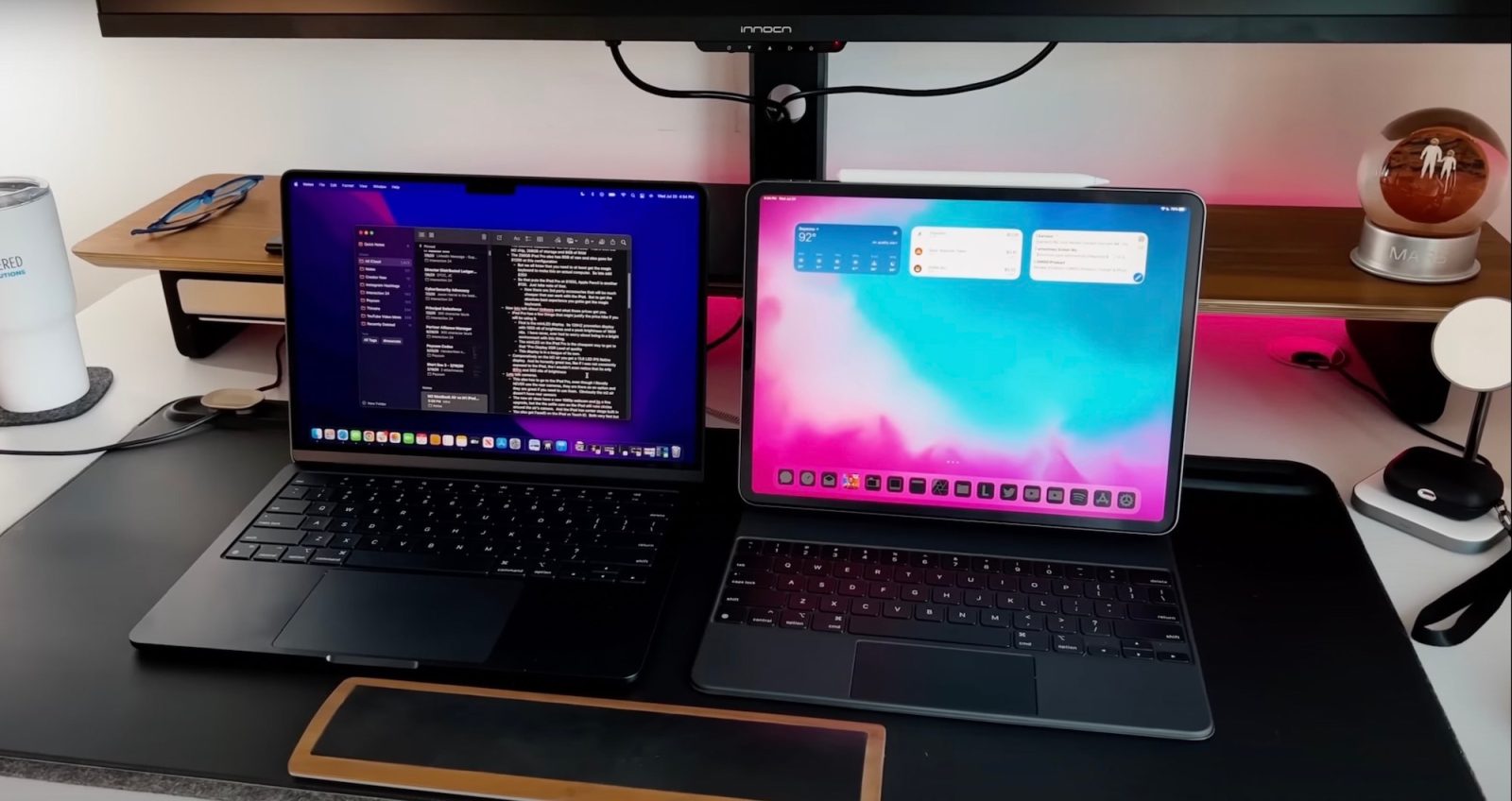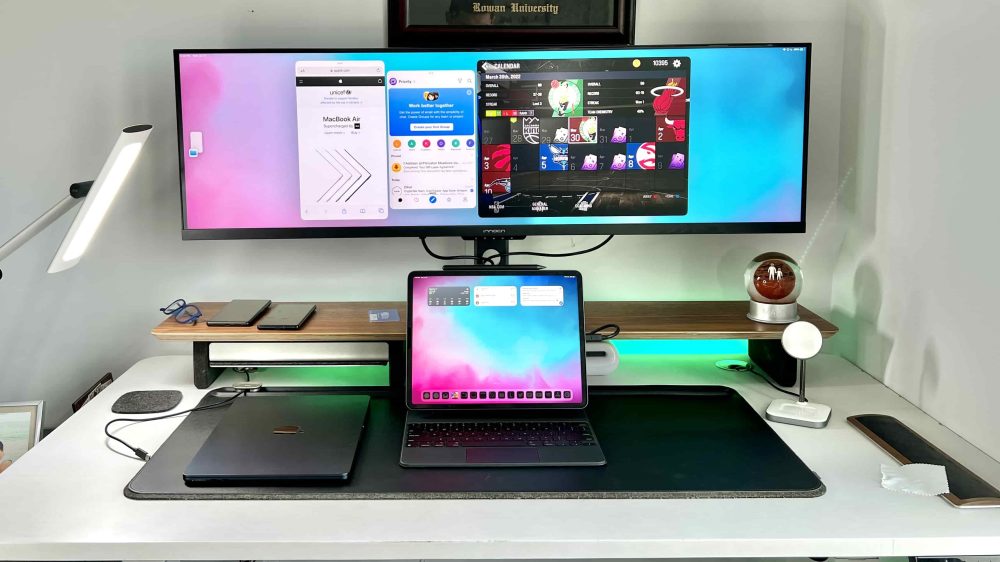
After using the M2 MacBook Air for over a week, I’m excited to share how it stacks up against the M1 iPad Pro. Here’s everything you need to know.
While the M1 iPad Pro is a powerful machine, I have still found myself using a MacBook Air for that 5% of tasks that I cannot easily do on the iPad. However, I still utilize both devices for all manner of tasks from creative work for YouTube and professional work in corporate suites like Microsoft to custom CRM software and much more.
Because of this, I feel I’m perfectly positioned to give some in-depth thoughts on just which “computer” is a better buy for you and your workflow to help you decide between M1 iPad Pro and the brand new M2 MacBook Air.
M2 MacBook Air vs. M1 iPad Pro: Price differences
For comparison’s sake, we’ll be talking about the M1 iPad Pro with 256GB of storage. The baseline MacBook Air will set you back about $1200. That’s with the latest M2 chip, 256GB of storage, and 8GB of RAM. The 256GB iPad Pro has 8GB of ram while also starting at $1200 for the same configuration. To truly be able to compare the M1 iPad Pro and the M2 MacBook Air, we will also need the magic keyboard accessory for the iPad Pro, which will add another $350 to the base price.
Adding that $350 accessory puts the M1 iPad Pro at $1550, and the optional Apple Pencil costs an additional $130. Luckily, there are third-party Bluetooth accessories that are much cheaper and work with the iPad. As with most Apple products, to get the absolute best usability and functionality, you simply have to get the magic keyboard.
See table below for a full price comparison:
| M2 MacBook Air | M1 iPad Pro (Wifi Only | ||||
| Price | Storage | RAM | Price | Storage | RAM |
| $1,199 | 256 GB | 8 GB | $1099 | 128 GB | 8 GB |
| $1,399 | 512 GB | 8 GB | $1199 | 256 GB | 8 GB |
| $1,599 | 1 TB | 8 GB | $1399 | 512 GB | 8 GB |
| $1,999 | 2 TB | 8 GB | $1799 | 1 TB | 16 GB |
| $2,399 | 2 TB | 24 GB | $2199 | 2 TB | 16 GB |
Comparing the M2 MacBook Air directly to the M1 iPad Pro is unfair given that the tablet needs a little extra hardware to be considered a “computer” in the same way – think keyboard and Bluetooth mouse.
M2 MacBook Pro vs M1 iPad Pro: Hardware comparisons
The iPad Pro has a few hardware features that might justify the price hike depending on how you use the tablet. First is the 12.9-inch miniLED display. The 120Hz ProMotion display has a base 1000 nit brightness level and a peak brightness level of 1600 nits. Because of this, you don’t have to worry about using the iPad Pro in bright or sunny environments. What’s more, the miniLED screen on the iPad Pro is still the cheapest way to get to Apple’s Pro Display XDR Level of quality. This puts the display in a league of its own.
Comparatively, on the M2 MacBook Air, you get a 13.6-inch LED IPS Retina display. In its own right, it’s great. When compared directly to the iPad Pro’s display, you will easily notice the 60Hz refresh rate and 500 nits maximum brightness.

When discussing cameras, the iPad Pro easily takes the win. While you might not use the dual rear cameras, you still have access to capable photo and video sensors. Even if you do not initially intend to use the rear camera setup, it’s there as an option and is more than capable if you need to use it.
Obviously, the M2 MacBook Air doesn’t have rear sensors. The new MacBook Air does have a brand new, upgraded 1080p webcam, and while it’s a fine upgrade, the selfie camera on the iPad still runs circles around the MacBook Air’s camera. On top of that, the iPad has Center Stage built in. For security, the iPad benefits from FaceID, but the M2 MacBook Air does include Touch ID. Both biometric security options are very fast, but FaceID is passive, and it doesn’t require an action from the user to get the device unlocked.
Audio and speakers
Listen for yourself in the video below, and you can hear that the iPad speakers are fuller, louder, and provide more base than the MacBook Air. They technically both have a quad-speaker system but the iPad is just a better speaker system.
Ports and expansion
If you value ports and expansion, the M2 MacBook Air is the obvious choice. Apple has reintroduced MagSafe back on the MacBook Air, and that frees up an additional Thunderbolt port. This means that you can have two devices or accessories plugged in, while on the iPad, you only have access to one port. This has to be shared with power and data passthrough but can be expanded with compatible USB-C hubs.
If you pick up the Magic Keyboard, it’s worth noting that there is a port for power. However, it is only usable for power access and cannot be used as an extra iPad Pro access or expansion port. Even though there are two ports, the MacBook Air still only supports one external display up to 6K resolution. The same is true with the iPad Pro, thanks to the addition of Stage Manager with iPad OS 16.

Battery: Lifespan, standby, and charging
When discussing charging, the battery life is one area where you will notice the largest difference. The MacBook Air is an absolute champion when it comes to battery longevity. Apple’s website claims that the M2-powered laptop has a maximum of 18 hours of lifespan. In our testing, we haven’t managed a full 18 hours, but after a full day of heavy use with third-party apps like Google Chrome and Microsoft Suite apps, the MacBook Air has zero issues. With this use case, we were still able to end the day with around 50% battery remaining. In our opinion, you can take this for a weekend of heavy use and not need to bring a charger.
Sadly, the iPad Pro cannot compete here in the lifespan stakes. Under heavy use with the Magic Keyboard, we regularly manage five to six hours before needing to seek out the charger.
When it comes to raw battery longevity, the M2 MacBook Air is a clear winner. Also, the iPad Pro’s max charging speed is rated at 33W compared to the MacBook Air that can charge up to 67W through MagSafe.
Design and functional hardware considerations
The iPad Pro with optional Magic Keyboard combo makes the iPad heavier and thicker than the MacBook Air. Although heavier it’s hard not to look toward the iPad Pro, at least in terms of the versatility and overall portability. Not only is it a tablet for entertainment purposes, but it’s also starting to become a powerful workhorse tool for many.
In many ways, the iPad is still the “must have” device on the market. Having owned the iPad since 2018, I personally made this decision based on aesthetics. It’s incredibly light, thin, and powerful. In many ways, it still seems too good to be true. Sure, the new MacBook Air design is amazing in its own right, but something about the iPad when paired with the Magic Keyboard — and its unique floating hinge design — feels like a better package.
So from a pure hardware perspective — price aside — I feel that the iPad Pro has the edge. With great versatility, better onboard cameras, and an arguably better display, it’s a top-of-the-line piece of tech, and that’s why Apple dominates this section of the market.
Final thoughts
In conclusion, which device is right for you is still solely based on preference and price. In my opinion, I would opt for the iPad Pro due to its portability, usability, and the fact it’s generally more fun to use. You have millions of apps on the App Store to choose from, so you’re always able to find something useful or entertaining. It’s simply more versatile – it’s a tablet, a digital notepad, a computer, and a game console all in one.
It’s hard to argue with the fact that many people just want a laptop that is familiar, works with everything — from work to productivity — is useable on a daily basis, and has great battery life. For this group, I would usually recommend the MacBook Air purely from a cost to performance and familiarity ratio.
If you can afford both, then the M1 iPad Pro and M2 MacBook Air complement each other perfectly thanks to features like side car, universal control, and Apple’s ecosystem.
Even though the M1 iPad Pro is a great choice for me, if I had to recommend a computer to use exclusively for the next five years, then it would be hard to look past the M2 MacBook Air. It offers powerhouse desktop-level performance in a portable chassis, with real desktop applications, a great keyboard, touchpad, and external display support without compromise.
FTC: We use income earning auto affiliate links. More.


Comments